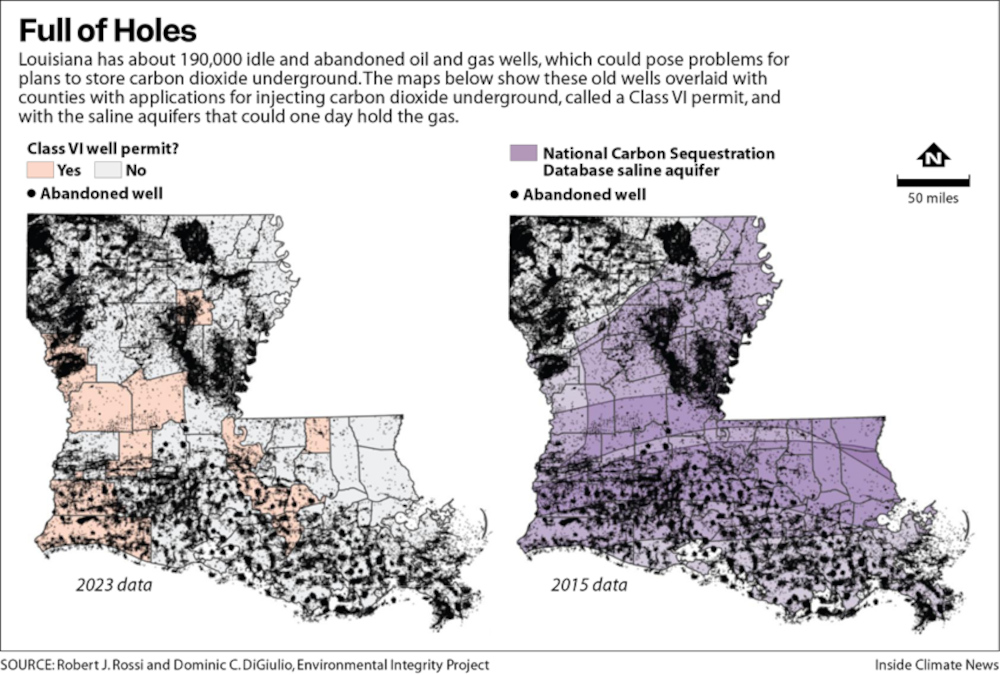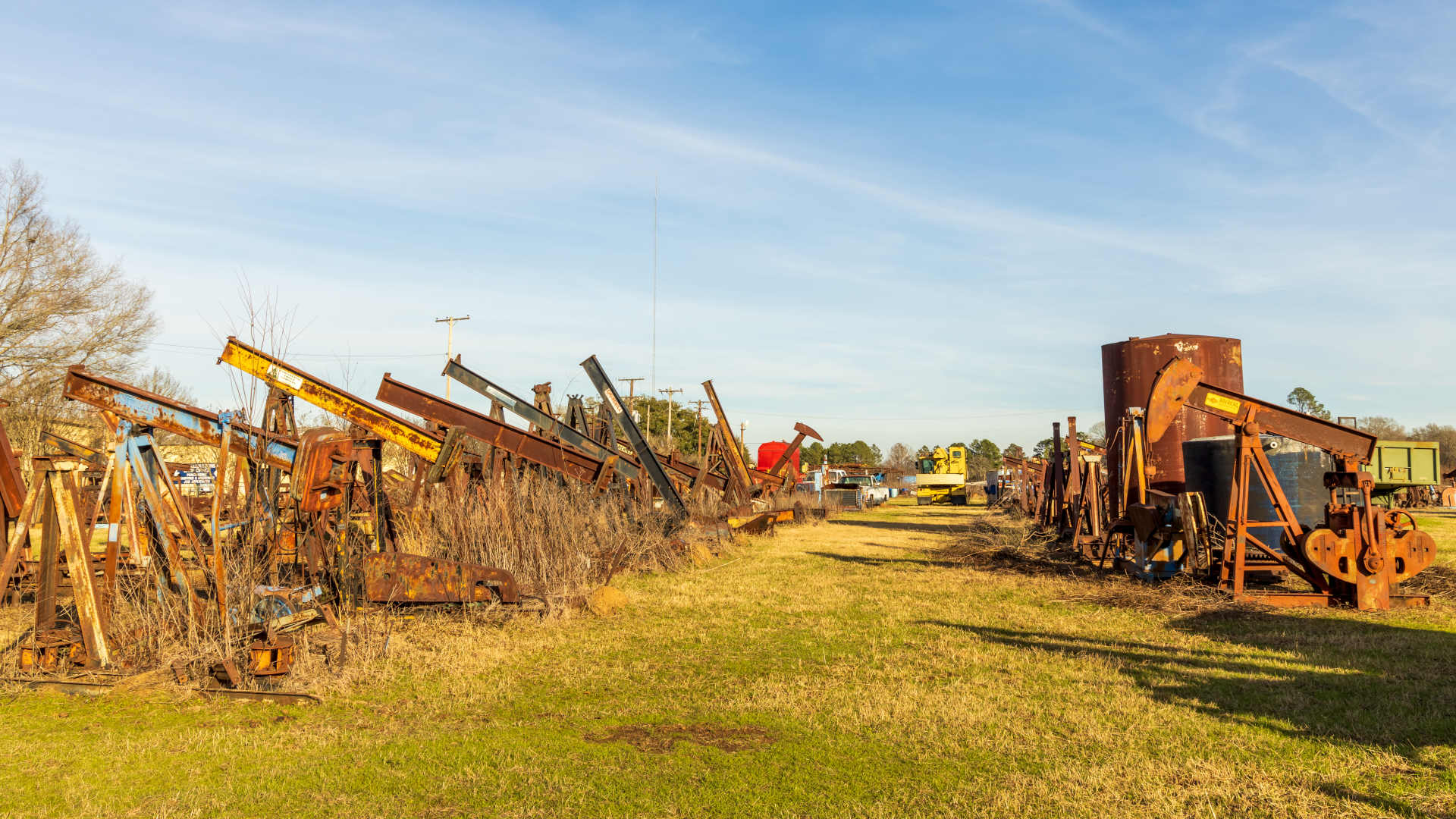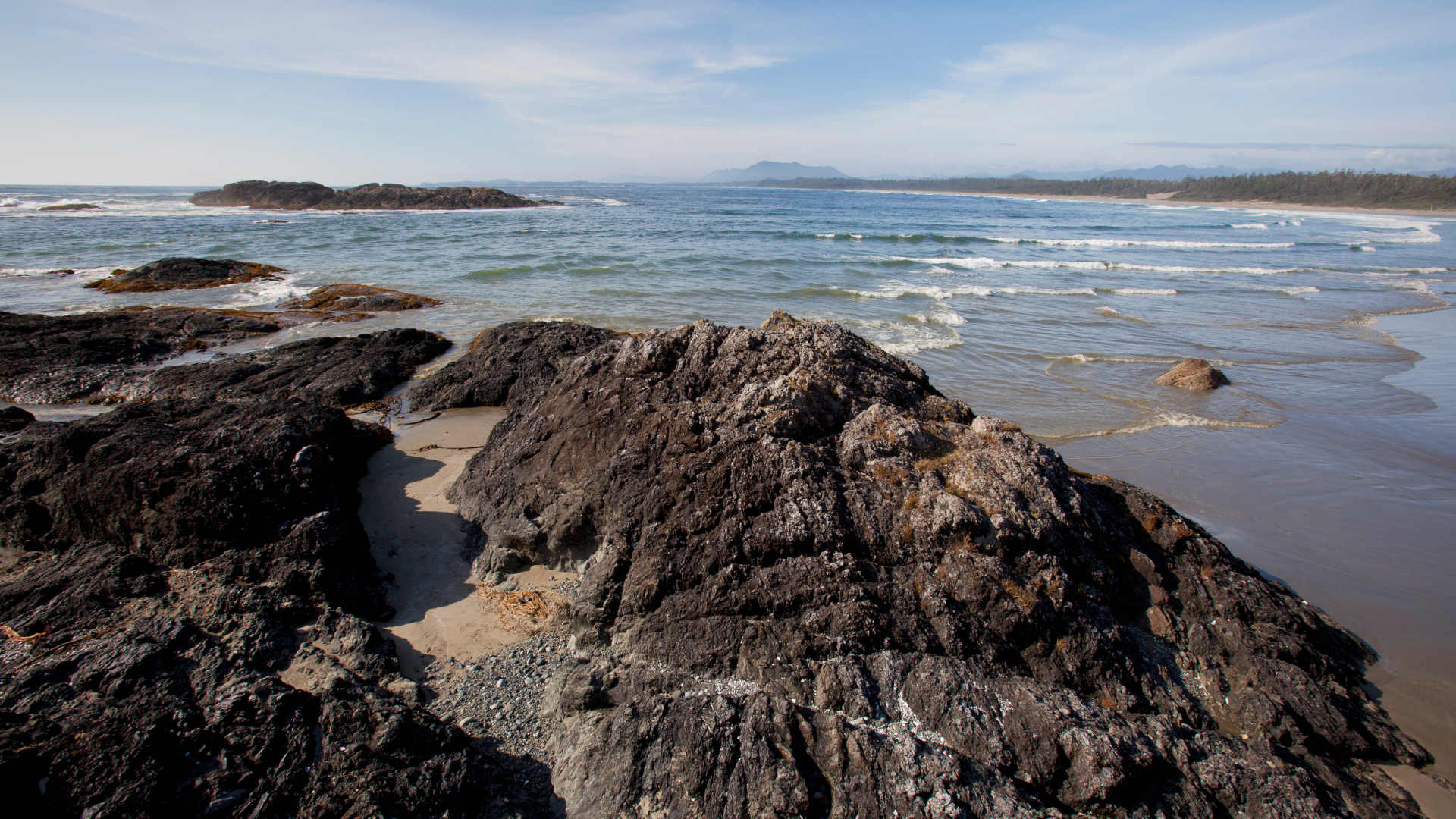A Weak Spot in Carbon Sequestration: Abandoned Oil and Gas Wells
After more than a century of pulling carbon from underground, a rush is underway to pump it back down. Companies have applied for scores of permits across the country to inject carbon dioxide deep into the earth. Several projects have already been approved.
With industry planning to inject tens of millions of tons annually, a looming question is whether the climate-warming gas will stay underground.
The most likely points of failure, experts say, could be some of the millions of abandoned oil and gas wells that perforate the nation, often in the same areas targeted for storing carbon dioxide underground. A new report underscores the risk those wells pose in Louisiana, home to more proposed carbon storage projects than any other state.
This story was originally published by Inside Climate News and is reproduced here as part of the Climate Desk collaboration.
There are about 120,000 abandoned wells in Louisiana overlying geological zones that could store carbon dioxide, more than 13,000 of which were plugged before modern standards were adopted in 1953, according to a report published by the Center for Applied Environmental Science at the Environmental Integrity Project, a watchdog group. A separate count, by the Louisiana-based advocacy group Healthy Gulf, looked within a 5-mile radius of the proposed projects and found about 7,000 oil and gas wells.
“It’s not a question of whether they’re going to leak,” said Abel Russ, director of the Center for Applied Environmental Science, which published an accompanying map of the wells. “It’s a question of how much, how often, and whether it’s an acceptable level of leakage.”
With support from the Biden administration and billions of dollars in new subsidies and tax incentives, energy companies and others are planning to capture millions of tons of industrial carbon dioxide emissions and then pipe the climate pollutant for underground storage, part of an effort to reduce the nation’s greenhouse gas pollution. Federal and state regulators are reviewing 69 projects or permits to store CO2 underground, with 24 of those in Louisiana. Nine projects have already been approved while one more, in California, is pending.
“It’s not a question of whether they’re going to leak. It’s a question of how much, how often, and whether it’s an acceptable level of leakage.”
Companies plan to inject carbon dioxide into porous rock formations that are usually filled with brine containing not only extremely high salt levels but often heavy metals, hydrocarbons, and radioactive elements. Brine leaks, therefore, can be even more worrying than the escape of CO2.
Many scientists who study underground carbon dioxide storage say the risk of large-scale leaks is low. While there will inevitably be some leaks, they say, they will likely be slow, detectable and relatively easy to fix.
“Alertness is reasonable, but great fear is not,” said Susan Hovorka, a senior research scientist at the Bureau of Economic Geology at the University of Texas, which is funded by government and energy companies involved in carbon storage.
Many environmental advocates remain skeptical, however, and they point to problems caused by the injection of oilfield wastewater under high pressure in West Texas and other regions, the best existing analogue for the planned industrial-scale storage of CO2.

In recent years, toxic brine has seeped and spewed out of old oil and gas wells across West Texas near wastewater injection wells, spouting more than 100 feet in the air and creating an artificial saline lake. The wastewater injections have also caused earthquakes, as the pressurized fluid interacts with faults. Carbon dioxide would be injected as a “supercritical” fluid that has properties of both a gas and liquid.
While the regulations for carbon dioxide storage are more rigorous than those that cover injection of other substances, abandoned oil wells represent a weak spot in the rules, said Dominic DiGiulio, a former EPA geoscientist and co-author of the new report.
“Plugged wells do leak. These wells were plugged a long time ago, and now we’re going to store supercritical CO2 under very high pressure and hope that these things somehow last thousands of years,” DiGiulio said. “It’s a problem.”
Environmental advocates are especially concerned about Louisiana, which recently became the third state, after North Dakota and Wyoming, to get EPA approval to regulate CO2 injection wells. Many advocacy groups worry the state is not equipped to handle oversight of this new and complex technical challenge, and they say state regulators have a history of deferring to the oil and gas industry. They point out that the new secretary of the Department of Energy and Natural Resources, which regulates the wells, previously led Louisiana’s chief oil and gas lobbying group.
Patrick Courreges, a department spokesman, said the secretary does not have control over regulators.
Picture a massive cake, with alternating layers of spongy, porous cake and dense, impermeable frosting. That’s more or less what the Earth’s crust is like, if those layers were bent and warped and made of rock.
Over millions of years, oil and gas accumulated in some of the porous layers, held in place by the frosting on top. Hovorka and others say the same geological features that held the hydrocarbons in place can now do the same for carbon dioxide.
The problem is that people, over the last 150 years or so, have poked some 3.9 million straws into the cake in the form of oil and gas wells, according to the EPA, puncturing the layers and opening up paths for fluids and gases to migrate up.
“Alertness is reasonable, but great fear is not.”
Hundreds of thousands of these abandoned wells have no records, so no one knows exactly where they are. Others may have been plugged with wood or in some cases not at all. Most wells are lined with steel casings that are cemented to the surrounding earth, and are plugged with cement once they’re out of use. But even properly drilled and plugged wells can fail over time as the steel corrodes or the cement degrades. Fluids and gases can then leak up these straws into groundwater or to the surface. Carbon dioxide is buoyant and will move upward if given the chance.
It is these leaky, old wells that have caused the geysers and artificial lakes in West Texas. Elsewhere, including in Louisiana, sinkholes have opened up, sometimes forcing evacuations. More commonly, the wells leak smaller amounts of brine and gas. The EPA estimates abandoned wells release about 300,000 metric tons of methane every year.
Many of the proposed carbon storage projects in Louisiana have at least a few and sometimes dozens of wells within a couple of miles. The Hackberry Carbon Sequestration project, which would inject up to 2 million tons of carbon dioxide captured from a liquified natural gas terminal and other sources in Louisiana, has more than 50 abandoned wells within a 2-mile radius, according to an analysis of state records by the Center for Applied Environmental Science. Many of those wells are unplugged, idle wells or wells that were plugged before 1953, when improved cement standards were established. Some were also drilled down to the depth of 8,000 feet, the level at which the project would inject its carbon dioxide, according to well logs.
The regulations say companies must identify each of the wells within a certain radius of the project and make sure they are properly plugged or secured. For any that are not, companies must plug the well, which can cost hundreds of thousands of dollars per well. The pending project in California will require plugging 157 nearby oil and gas wells, according to the draft permit.
That is what’s supposed to happen, but DiGiulio said there are several points where this process could fail. There could be undocumented wells, which companies would have to find, either through aerial imaging or field surveys. For wells that are on the books, the regulations do not require companies to do more than checking the record to see if it is plugged, DiGiulio said. It is at the discretion of the regulator whether companies must perform tests on the wells to make sure the records are correct, and that the cement surrounding or plugging the well has not deteriorated.
What’s more, DiGiulio said, even properly plugged wells can leak. He and others have conducted research in Pennsylvania indicating that plugged wells leak more than 130 kilograms of methane a year on average, with some leaking far more.
The “area of review” that companies must survey is defined as the zone within which the project’s injections will increase underground pressure. This zone extends far beyond the plume of carbon dioxide, and can be influenced by any number of variables including the temperature and physical characteristics of the rock and the rate of injection. Companies use modeling to determine their areas of review, but research by Hovorka and others has shown that if two or more projects are injecting into the same zones and are close enough together, the areas they affect can meet and grow to be larger than either project’s model would predict independently.
“These wells were plugged a long time ago, and now we’re going to store supercritical CO2 under very high pressure and hope that these things somehow last thousands of years. It’s a problem.”
One 2009 study by scientists at Lawrence Berkeley National Laboratory modeled what would happen if 20 hypothetical projects injected a combined 100 million tons per year into the Illinois Basin, in the Midwest. That volume is far more than currently proposed anywhere but in line with what could be needed if carbon storage becomes a significant industry. The researchers found that the areas of review would essentially combine into one giant, pressurized zone that would extend more than 100 miles beyond the injection wells. The companies, therefore, would need to identify and test abandoned wells across more than 38,000 square miles, which could prove to be impractical or cost prohibitive.
Jens Birkholzer, a co-author of the study and a senior scientist at Lawrence Berkeley, said he thinks the risk of leaks is extremely low. The study was modeling a hypothetical situation far in the future, he said, though the concept they were studying could come into play as projects come online.
DiGiulio said scientists with that perspective generally assume that the regulations are implemented and enforced properly, an expectation he said is not supported by history.
“How can you say this isn’t a problem?” DiGiulio said, pointing to the leaks and blowouts in West Texas.
Courreges, the Department of Energy and Natural Resources spokesman, said the regulators are aware of the potential for projects to interact and that they take seriously the risks posed by abandoned wells.
“They need to demonstrate to our satisfaction that it’s properly plugged,” Courreges said of companies proposing projects. That could entail simply checking records for newer wells, he said, or conducting field tests for older ones. “Is there a possibility some old well will be missed?” Courreges said. “Nothing can be ruled out 100 percent,” but he said most areas have good documentation.
Sempra Infrastructure, the company behind the Hackberry project, said there are no other wells within the project’s area of review and that the company would “utilize real-time monitoring with the most advanced fiber optic technology and regular site visits to ensure Sempra Infrastructure’s commitment to safety and sustainability.”
The size of the project’s area of review remains confidential and Sempra did not answer a question asking how far it extends.
“Is there a possibility some old well will be missed? Nothing can be ruled out 100 percent.”
The challenge abandoned wells present to carbon dioxide storage proposals is not unique to Louisiana. Texas has also applied to regulate CO2 injection wells, a prospect that troubles Paige Powell, policy manager at Commission Shift, an energy watchdog group in that state. Her organization recently sent a letter to the EPA asking it to revoke Texas’s oversight of wastewater injection wells — Texas and most other states already have primacy for wastewater injection wells — citing the recent blowouts and leaks from abandoned wells.
“There’s things happening in the subsurface that they don’t know about,” Powell said, adding that she was skeptical of claims that CO2 injection wells won’t leak. “I think it’s audacious to say it’s not going to happen.”
Russ, with the Center for Applied Environmental Science, said he was troubled by the lack of information available about the carbon storage applications. Many details remain secret, and won’t be published until the state opens draft permits for public review.
“Everyone is stuck in this position of being uninformed and skeptical, and that’s not a great place to be in,” Russ said. “It’s just moving so fast, it’s so novel and so untested, there are a lot of unanswered questions and the lack of information in that context is bad.”
Nicholas Kusnetz is a reporter for Inside Climate News.












Great article.
See this company: http://www.ventbusters.com
I worked on this product for several years. Permits monitoring of the low-flow methane emissions from abandoned wells. In many jurisdictions, including mine (Alberta), regulators don’t permit wells to be plugged / capped until they are truly “abandoned” for fear of methane buildup.
Companies can kick the can down the road for years by doing a minimum amount of service on a well. Considerably less expensive than the $250K – $1000K to truly plug/cap a well. Alberta has between 100,000 and 170,000 wells that are abandoned (still owned by a viable company, with insufficient output) and orphaned (no owner because the company that owned the well is defunct).
Orphaned wells are a byproduct of bad governance – government of Alberta didn’t ask for sufficient bonding to pay for cleanup. Liability in Alberta is between $100B and $230B (B=billion!) to clean up all wells.
In the USA, Wyoming has done a better job on bonding; other jurisdictions I am unaware.
You can’t pump it as a gas. you got to lock it in organic matter, char it, make a slurry and then pump it down there. You use it when we drill for oil as they are already pumping stuff down there to get the oil out in the first place.